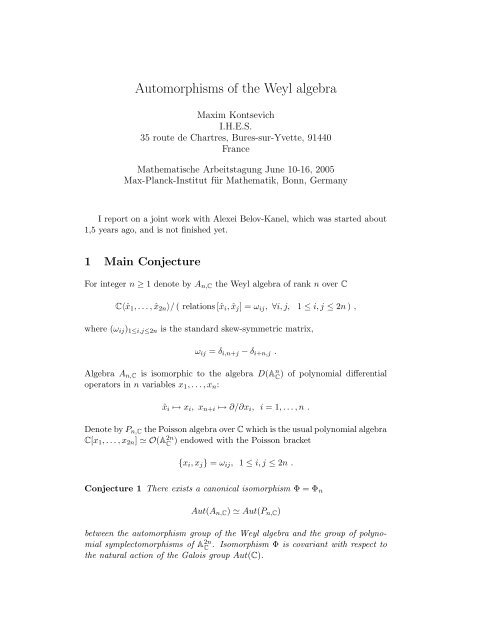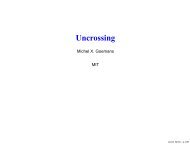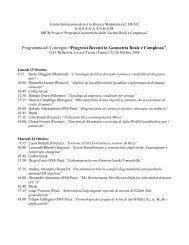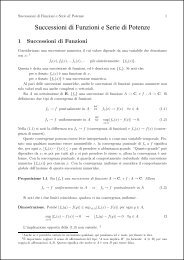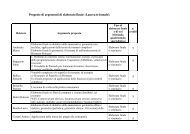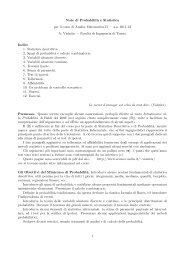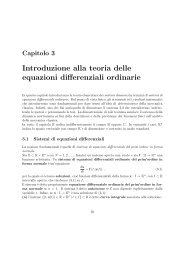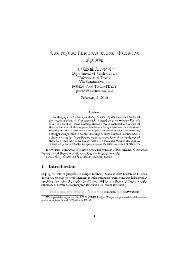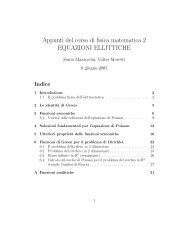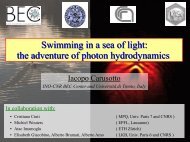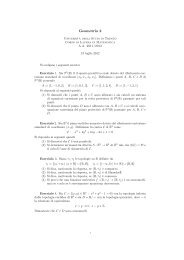Automorphisms of the Weyl algebra - IHES
Automorphisms of the Weyl algebra - IHES
Automorphisms of the Weyl algebra - IHES
You also want an ePaper? Increase the reach of your titles
YUMPU automatically turns print PDFs into web optimized ePapers that Google loves.
<strong>Automorphisms</strong> <strong>of</strong> <strong>the</strong> <strong>Weyl</strong> <strong>algebra</strong><br />
Maxim Kontsevich<br />
I.H.E.S.<br />
35 route de Chartres, Bures-sur-Yvette, 91440<br />
France<br />
Ma<strong>the</strong>matische Arbeitstagung June 10-16, 2005<br />
Max-Planck-Institut für Ma<strong>the</strong>matik, Bonn, Germany<br />
I report on a joint work with Alexei Belov-Kanel, which was started about<br />
1,5 years ago, and is not finished yet.<br />
1 Main Conjecture<br />
For integer n ≥ 1 denote by A n,C <strong>the</strong> <strong>Weyl</strong> <strong>algebra</strong> <strong>of</strong> rank n over C<br />
C〈ˆx 1 , . . . , ˆx 2n 〉/ ( relations [ˆx i , ˆx j ] = ω ij , ∀i, j, 1 ≤ i, j ≤ 2n ) ,<br />
where (ω ij ) 1≤i,j≤2n is <strong>the</strong> standard skew-symmetric matrix,<br />
ω ij = δ i,n+j − δ i+n,j .<br />
Algebra A n,C is isomorphic to <strong>the</strong> <strong>algebra</strong> D(A n C<br />
) <strong>of</strong> polynomial differential<br />
operators in n variables x 1 , . . . , x n :<br />
ˆx i ↦→ x i , x n+i ↦→ ∂/∂x i , i = 1, . . . , n .<br />
Denote by P n,C <strong>the</strong> Poisson <strong>algebra</strong> over C which is <strong>the</strong> usual polynomial <strong>algebra</strong><br />
C[x 1 , . . . , x 2n ] ≃ O(A 2n<br />
C<br />
) endowed with <strong>the</strong> Poisson bracket<br />
{x i , x j } = ω ij , 1 ≤ i, j ≤ 2n .<br />
Conjecture 1 There exists a canonical isomorphism Φ = Φ n<br />
Aut(A n,C ) ≃ Aut(P n,C )<br />
between <strong>the</strong> automorphism group <strong>of</strong> <strong>the</strong> <strong>Weyl</strong> <strong>algebra</strong> and <strong>the</strong> group <strong>of</strong> polynomial<br />
symplectomorphisms <strong>of</strong> A 2n<br />
C<br />
. Isomorphism Φ is covariant with respect to<br />
<strong>the</strong> natural action <strong>of</strong> <strong>the</strong> Galois group Aut(C).
1.1 First positive evidence: case n = 1<br />
The structure <strong>of</strong> group Aut(P 1,C ) is known after H.W.E.Young (1942) and W.<br />
van der Kulk (1953). This group contains <strong>the</strong> group G 1 = SL(2, C) ⋉ C 2 <strong>of</strong><br />
special affine transformations, and solvable group G 2 <strong>of</strong> polynomial transformations<br />
<strong>of</strong> <strong>the</strong> form<br />
(x 1 , x 2 ) ↦→ (λx 1 + F (x 2 ), λ −1 x 2 ), λ ∈ C × , F ∈ C[x] .<br />
Group Aut(P 1,C ) is equal to <strong>the</strong> amalgamated product <strong>of</strong> G 1 and G 2 over <strong>the</strong>ir<br />
intersection. L.Makar-Limanov (1984) proved that if one replaces commuting<br />
variables x 1 , x 2 by noncommuting variables ˆx 1 , ˆx 2 in above formulas, one<br />
obtains <strong>the</strong> description <strong>of</strong> group Aut(A 1,C ). Hence, in <strong>the</strong> case n = 1 two<br />
automorphism groups are isomorphic.<br />
1.2 Negative evidence: Lie <strong>algebra</strong>s are not isomorphic<br />
Groups Aut(A n,C ) and Aut(P n,C ) are in fact groups <strong>of</strong> complex points <strong>of</strong> certain<br />
group-like ind-affine schemes Aut(A n,C ) and Aut(P n,C ). Namely, an automorphism<br />
φ <strong>of</strong> A n,C such that both φ, φ −1 map all generators ˆx i to expressions<br />
<strong>of</strong> degree bounded by some integer N ≥ 1, is a solution <strong>of</strong> certain system <strong>of</strong><br />
polynomial equations in variables c i,I , c ′ i,I (coefficients <strong>of</strong> φ and φ−1 ):<br />
φ(ˆx i ) =<br />
∑<br />
I: |I|≤N<br />
c i,I ˆx I , φ −1 (ˆx i ) = ∑<br />
I: |I|≤N<br />
where for multi-index I = (i 1 , . . . , i 2n ) ∈ Z 2n<br />
≥0 we define<br />
ˆx I := ˆx i 1<br />
1 . . . ˆx i 2n<br />
2n , |I| := i 1 + · · · + i 2n .<br />
c ′ i,I ˆxI ,<br />
Similarly, one has an ind-scheme Aut(P n,C ), an inductive limit <strong>of</strong> a chain <strong>of</strong><br />
affine schemes <strong>of</strong> finite type over C. Using dual numbers C[t]/(t 2 ) one defines<br />
as usual Lie <strong>algebra</strong>s <strong>of</strong> ind-schemes Aut(A n,C ) and Aut(P n,C ). These <strong>algebra</strong>s<br />
are derivations Der(A n,C ) and Der(P n,C ) respectively. It is well-known that all<br />
derivations <strong>of</strong> A n,C are inner,<br />
Der(A n,C ) ≃ A n,C / C · 1 An,C .<br />
Similarly, derivations <strong>of</strong> P n,C are hamiltonian vector fields,<br />
Der(P n,C ) ≃ P n,C / C · 1 Pn,C .<br />
These two Lie <strong>algebra</strong>s are not isomorphic: Der(P n,C ) contains many non-trivial<br />
Lie sub<strong>algebra</strong>s <strong>of</strong> finite codimension (e.g. vector fields vanishing at some point<br />
<strong>of</strong> A 2n<br />
C ), while Der(A n,C) does not contain such sub<strong>algebra</strong>s (in a sense it is<br />
similar to sl ∞ ).<br />
Thus, we conclude that <strong>the</strong> conjectural isomorphism Φ can not be an isomorphism<br />
<strong>of</strong> ind-schemes. In fact, we expect that Φ preserves <strong>the</strong> filtration <strong>of</strong><br />
automorphism groups by degree, and it is a constructible continuous map, both<br />
in Zariski and usual topology.
1.3 Ano<strong>the</strong>r positive evidence: tame automorphisms<br />
Symplectic group Sp(2n, C) acts by automorphisms <strong>of</strong> A n,C and <strong>of</strong> P n,C by linear<br />
transformations <strong>of</strong> generators. Also, for any polynomial F ∈ C[x 1 , . . . , x n ] we<br />
define non-linear transvections<br />
by formulas<br />
T P F ∈ Aut(A n,C ), T A F ∈ Aut(P n,C )<br />
T P F (x i ) = x i , T P F (x n+i ) = x n+i + ∂ i F (x 1 , . . . , x n ), 1 ≤ i ≤ n ,<br />
T A F (ˆx i) = ˆx i , T P F (ˆx n+i) = ˆx n+i + ∂ i F (ˆx 1 , . . . , ˆx n ), 1 ≤ i ≤ n .<br />
The last formual makes sense, as variables ˆx 1 , . . . , ˆx n commute with each o<strong>the</strong>r.<br />
Correspondence F ↦→ TF P (resp. F ↦→ T F A ) gives a group homomorphism<br />
C[x 1 , . . . , x n ]/C · 1 → Aut(P n,C ) (resp. to Aut(A n,C )). <strong>Automorphisms</strong> <strong>of</strong> A n,C<br />
and <strong>of</strong> P n,C generated by Sp(2n, C) and transvections are called tame.<br />
We prove in <strong>the</strong> next section that groups <strong>of</strong> tame automorphisms <strong>of</strong> A n,C and<br />
<strong>of</strong> P n,C are canonically isomorphic. Symplectic group Sp(2n, C) is generated by<br />
Fourier transform<br />
x i ↦→ x n+i , x n+i ↦→ −x i ; ˆx i ↦→ ˆx n+i , ˆx n+i ↦→ −ˆx i , i = 1, . . . , n<br />
and by transvections corresponding to quadratic polynomials F . Our assertion<br />
follows from <strong>the</strong> following <strong>the</strong>orem:<br />
Theorem 1 For any sequence <strong>of</strong> polynomials F 1 , . . . , F k ∈ C[x 1 , . . . , x n ]/C · 1<br />
<strong>the</strong> composition<br />
F ourier ◦ T A F 1<br />
◦ F ourier ◦ · · · ◦ T A F k<br />
is identity in Aut(A n,C ) if and only if <strong>the</strong> composition<br />
is identity in Aut(P n,C ).<br />
2 Pro<strong>of</strong> <strong>of</strong> <strong>the</strong>orem 1<br />
F ourier ◦ T P F 1<br />
◦ F ourier ◦ · · · ◦ T P F k<br />
Notice that in <strong>the</strong> definition <strong>of</strong> <strong>algebra</strong>s A n,C and P n,C one can replace C by<br />
arbitrary commutative ring.<br />
The only known pro<strong>of</strong> <strong>of</strong> Theorem 1 is based on considerations in finite<br />
characteristic. It is a challenge to find a purely complex pro<strong>of</strong>. In fact, in <strong>the</strong><br />
case n = 1, J.Dixmier in 1968 described automorphisms <strong>of</strong> A 1 in finite characteristic,<br />
and L.Makar-Limanov used <strong>the</strong> result <strong>of</strong> Dixmier in zero characteristic.<br />
Here we follow <strong>the</strong> same line.<br />
Let us assume that <strong>the</strong> composition in Aut(A n,C ) is equal to identity. We<br />
want to prove that <strong>the</strong> corresponding composition in Aut(P n,C ) is also equal to<br />
identity.<br />
Let us denote by R ⊂ C <strong>the</strong> subring <strong>of</strong> C generated by all coefficients <strong>of</strong><br />
polynomials F 1 , . . . , F k . It is a finitely generated integral domain. Hence for all
sufficiently large primes p ≫ 1 <strong>the</strong> reduction R/p := R ⊗ Z/pZ is a non-zero<br />
ring. For any prime p <strong>Weyl</strong> <strong>algebra</strong> A n,R/p has a large center,<br />
Center(A n,R/p ) = R/p [ˆx p 1 , . . . , ˆxp 2n ] .<br />
Any automorphism φ p <strong>of</strong> A n,R/p induces an automorphism <strong>of</strong> its center. If we<br />
replace generators ˆx p i , i = 1, . . . , 2n <strong>of</strong> Center(A n,R/p) by letters x i , we obtain a<br />
polynomial automorphism φ centr<br />
p in characteristic p. One sees immediately that<br />
<strong>the</strong> Fourier transfrom maps to Fourier transform. Almost <strong>the</strong> same happens<br />
for transvections:<br />
(TF A (mod p) )centr = TF P r p(F ) ,<br />
where F r p (F ) := ∑ I cp I xI for F = ∑ I c Ix I . It follows immediately from a<br />
simple identity in zero characteristic for differential operators in one variable:<br />
(∂/∂x + g ′ (x)) p = (∂/∂x) p + (g ′ (x)) p (mod p) .<br />
Thus, we see that <strong>the</strong> composition F ourier ◦ TF P 1<br />
◦ F ourier ◦ · · · ◦ TF P k<br />
(after<br />
application <strong>of</strong> <strong>the</strong> Frobenius map F r p to its coefficients) coinsides with <strong>the</strong><br />
identity morphism modulo p for all sufficiently large primes p. Hence it is equal<br />
to identity in Aut(A n,R ) ⊂ Aut(A n,C ). Implication in one direction is proven.<br />
Conversely, let us assume that <strong>the</strong> composition φ A is not equal to identity<br />
in Aut(A n,R ). Then it is ei<strong>the</strong>r a non-trivial affine map on generators, or it<br />
maps some generator ˆx i to an expression <strong>of</strong> degree d > 1. In <strong>the</strong> first case one<br />
can show that <strong>the</strong> composition φ P is not equal to identity, as after application<br />
<strong>of</strong> Frobenius one obtains affine map φ centr<br />
p ≠ id. In <strong>the</strong> second case <strong>the</strong> image<br />
<strong>of</strong> ˆx p i<br />
has degree strictly equal to pd as its symbol is p-th power <strong>of</strong> <strong>the</strong> degree d<br />
symbol <strong>of</strong> ˆx i . Hence, we have again φ centr<br />
p ≠ id. This finishes <strong>the</strong> pro<strong>of</strong> <strong>of</strong> <strong>the</strong><br />
inverse implication.<br />
3 Conjectural description <strong>of</strong> Φ<br />
The above proo<strong>of</strong> give an indication how <strong>the</strong> homomorphism Φ : Aut(A n,C ) →<br />
Aut(P n,C ) should be defined in general. Namely, as before, we can assume that<br />
φ ∈ Aut(A n,C ) is defined over a finitely generated integral domain R ⊂ C.<br />
For any prime p we obtain a polynomial map φ centr<br />
p ∈ Aut(R/p [x 1 , . . . , x 2n ] by<br />
restriction <strong>of</strong> φ mod p to <strong>the</strong> center <strong>of</strong> A n,R/p .<br />
The next step is to prove that φ centr<br />
p is a symplectomorphism. For sufficiently<br />
large p ring R is flat over p ∈ Spec(Z), hence A n,R /p 2 is flat over Z/p 2 .<br />
We can consider A n,R/p 2 as an infinitesimal one-step deformation <strong>of</strong> associative<br />
<strong>algebra</strong> A n,R/p . In <strong>the</strong> usual way, one associates to this deformation a canonical<br />
Poisson bracket on <strong>the</strong> center <strong>of</strong> A n,R/p :<br />
{a, b} :=<br />
[ã, ˜b]<br />
p<br />
(mod p) ,<br />
where ã, ˜b ∈ A n,R /p 2 are arbitrary lifts <strong>of</strong> central elements a, b ∈ Center(A n,R/p ).<br />
A straightforward calculation:<br />
[(∂/∂x) p , x p ] = −p (mod p 2 )
shows that one get <strong>the</strong> usual Poisson bracket on R/p [x 1 , . . . , x 2n ] ≃ Center(A n,R/p ).<br />
Hence, we conclude that φ centr<br />
p is a symplectomorphism for p ≫ 1. For any p<br />
<strong>the</strong> degree <strong>of</strong> φ centr<br />
p is bounded from above by <strong>the</strong> degree <strong>of</strong> φ.<br />
Let us denote by R ∞ <strong>the</strong> following ring:<br />
∏<br />
(R/p) /<br />
⊕<br />
(R/p)<br />
primes p<br />
primes p<br />
It contains R ⊗ Q, and it has a “universal” Frobenius endomorphism F r R :<br />
R ∞ → R ∞ , (a p ) ↦→ (a p p). Our construction <strong>of</strong> symplectomorphisms φ centr<br />
p for<br />
all p ≫ 1 can be interpreted as a map<br />
Φ centr : Aut(A n,R ) → Aut(P n,R∞ ), φ ↦→ (φ centr<br />
p ) .<br />
The example <strong>of</strong> tame automorphisms shows that it is not exactly <strong>the</strong> conjectural<br />
map Φ which we want to construct, one should first untwist by Frobenius<br />
coefficents <strong>of</strong> symplectomorphisms φ centr<br />
p . This can be done in general, by <strong>the</strong><br />
following result:<br />
Theorem 2 For any finitely generated ring R which is smooth and dominant<br />
over Z, <strong>the</strong> image <strong>of</strong> <strong>the</strong> map Φ centr belongs to Aut(P n,F rR (R ∞)) ⊂ Aut(P n,R ).<br />
This <strong>the</strong>orem is applicable to automorphisms over C because any finitely generated<br />
integral domain R ⊂ C can be made smooth over Z by adding inverses<br />
<strong>of</strong> finitely many non-zero elements.<br />
3.1 Pro<strong>of</strong> <strong>of</strong> Theorem 2<br />
Let us choose (under <strong>the</strong> assumption that R is smooth and dominant over Z)<br />
a finite collection <strong>of</strong> derivations δ 1 , . . . , δ k ∈ Der(R) which span <strong>the</strong> tangent<br />
space at every closed point <strong>of</strong> Spec(R). An element a ∈ R/p belongs to (R/p) p<br />
if and only if it is killed by all derivations δ j . Therefore, we have to prove that<br />
for all p ≫ 1 and any i, j, one has<br />
Equivalently, we have to show that<br />
δ j (φ centr<br />
p (x i )) = 0 ∈ R/p [x 1 , . . . , x 2n ] .<br />
δ j (φ p (ˆx p i )) = 0 ∈ A n,R/p .<br />
The l.h.s <strong>of</strong> <strong>the</strong> above expression is equal to<br />
where<br />
δ j ((φ pˆx i ) p ) = a p−1 b + a p−2 ba + · · · + ba p−1 (mod p)<br />
a := φ(ˆx i ), b := δ j (a), a, b ∈ A n,R .<br />
Notice that for any i element ˆx i is locally ad-nilpotent in A n,R , that is for any<br />
element f ∈ A n,R <strong>the</strong> iterated commutator (ad(ˆx i )) m (f) vanishes for sufficiently<br />
large m (in fact m = deg(f)+1 suffices). Hence, element a = φ(ˆx i ) is also locally<br />
ad-nilpotent, and <strong>the</strong>re exists positive integer N such that (ad(a)) N (b) = 0.<br />
Finally, for any prime p ≥ N + 1 one has<br />
( ) p − 1<br />
0 = (ad(a)) p−1 (b) = a p−1 b − a p−2 ba + · · · + ba p−1 =<br />
1<br />
= a p−1 b + a p−2 ba + · · · + ba p−1 (mod p) .
3.2 Lifting to characteristic zero<br />
By Theorem 2 we know that <strong>the</strong> Φ centr (φ) is a polynomial symplectomorphism<br />
with coefficients in F r R (R ∞ ) ⊂ R ∞ . We define Φ untwisted (φ) to be an element<br />
<strong>of</strong> Aut(P n,R∞ ) obtained from Φ centr (φ) by <strong>the</strong> inverse Frobenius map (it is<br />
well-defined because F r R is injective for any integral domain R).<br />
Conjecture 2 For any finitely generated integral domain R smooth and dominant<br />
over Z and any φ ∈ Aut(A n,R ), element Φ untwisted (φ) belongs to subgroup<br />
Aut(P n,R⊗Q ) ⊂ Aut(P n,R∞ ).<br />
If we assume Conjecture 2, <strong>the</strong>n <strong>the</strong> map Φ from Conjecture 1 is defined by<br />
Φ(φ) := Φ untwisted (φ) ⊂ Aut(P n,R⊗Q ) ⊂ Aut(A n,C )<br />
We know that conjecture 2 holds for tame automorphisms. In general, I can<br />
prove a good approximation:<br />
Theorem 3 Under <strong>the</strong> same assumptions as in Conjecture 2, element Φ untwisted (φ)<br />
belongs to Aut(P n, ˜R), where ˜R ⊂ R ∞ is a finitely generated ring (not necessarily<br />
integral) containing R and finite over <strong>the</strong> generic point <strong>of</strong> Spec(R).<br />
The above <strong>the</strong>orem implies that <strong>the</strong>re exists a homomorphism<br />
Aut(A n,Q<br />
) → Aut(P n,Q<br />
)<br />
which may be not covariant with respect to <strong>the</strong> natural Aut(Q) action.<br />
I will not give here <strong>the</strong> pro<strong>of</strong> <strong>of</strong> <strong>the</strong>orem 3. It is based on some geometric<br />
considerations relating general holonomic modules over <strong>the</strong> <strong>Weyl</strong> <strong>algebra</strong>, and<br />
singular lagrangian subvarieties <strong>of</strong> A 2n .<br />
4 Conjectural description <strong>of</strong> Φ −1<br />
Here we propose a candidate for <strong>the</strong> inverse map<br />
Φ −1 : Aut(P n,C ) → Aut(A n,C ) .<br />
As before, we may assume that ψ ∈ Aut(P n,C ) is defined over a finitely generated<br />
integral domain R ⊂ C. We know already <strong>the</strong> automorphism Φ −1 (ψ)<br />
(mod p) <strong>of</strong> <strong>algebra</strong> A n,R/p should induce symplectomorphism F r p (ψ p ) on its<br />
center for any prime p ≫ 1. We will show here that it lifts to at most unique<br />
automorphism <strong>of</strong> A n,R/p .<br />
Algebra A n,R/p is an Azumaya <strong>algebra</strong> over its center, a twisted form <strong>of</strong><br />
matrix <strong>algebra</strong> Mat(p n × p n , R/p [ˆx p 1 , . . . , ˆxp 2n ]). It has an invariant<br />
[A n,R/p ] ∈ Br(R/p [x 1 , . . . , x 2n ])<br />
in <strong>the</strong> Brauer group <strong>of</strong> its center Center(A n,R/p ) ≃ R/p [x 1 , . . . , x 2n ], <strong>the</strong> group<br />
<strong>of</strong> Morita equivalence classes <strong>of</strong> Azumaya <strong>algebra</strong>s.
For any commutative <strong>algebra</strong> S in finite characteristic p > 0 <strong>the</strong>re is a<br />
canonical map<br />
Ω 1 abs (S)/dΩ0 (S) → Br(S), Ω 1 abs (S) := Ω1 (S/Z) ,<br />
given by <strong>the</strong> formula fdg ↦→ [A f,g ]. Here for any two elements f, g ∈ S one<br />
defines Azumaya <strong>algebra</strong> A f,g over S as<br />
A f,g := S〈ξ, η〉/ relations ξ p = f, η p = g, [ξ, η] = 1 .<br />
It follows from definitions that <strong>the</strong> class [A n,R/p ] is given by <strong>the</strong> class <strong>of</strong> 1-form<br />
α :=<br />
n∑<br />
x i dx n+i ∈ Ω 1 abs (R[x 1, . . . , x 2n ]) .<br />
i=1<br />
Let us denote by α 0 <strong>the</strong> same 1-form considered as a relative form over R.<br />
Symplectomorphism ψ preserves 2-form dα 0 , hence (by Poincaré lemma) <strong>the</strong>re<br />
exists a function W ∈ R ⊗ Q[x 1 , . . . , x 2n ] such that ψ ∗ (α 0 ) = α 0 + dW . We<br />
enlarge R by adding inverses to prime numbers which appear in denominators<br />
<strong>of</strong> coefficients <strong>of</strong> W . Symplectomorphism F r p (ψ) for p ≫ 1 preserves <strong>the</strong> class<br />
<strong>of</strong> <strong>the</strong> absolute form α modulo differentials, because all coefficients <strong>of</strong> F r p (ψ) are<br />
p-th powers, and <strong>the</strong>refore can be treated as “constants” (<strong>the</strong>y have vanishing<br />
derivatives).<br />
The conclusion is that for all p ≫ 1 <strong>the</strong>re exists a Morita self-equivalence <strong>of</strong><br />
<strong>algebra</strong> A n,R/p inducing automorphism F r p (ψ) on its center. This Morita selfequivalence<br />
is given by a bimodule M ψ,p over A n,R/p , which is finitely generated<br />
projective both as left and as right module. Moreover, it is easy to see that<br />
such bimodule is unique up to an isomorphism, and its automorphism group is<br />
<strong>the</strong> group <strong>of</strong> multiplications by scalars (R/p) × .<br />
Conjecture 1 follows from Conjecture 2 and <strong>the</strong> following<br />
Conjecture 3 Bimodule M ψ,p is free rank one as left and as right A n,R/p -<br />
module.<br />
Namely, if M ψ,p is free rank one module on both sides, <strong>the</strong>n choosing <strong>the</strong><br />
generator <strong>of</strong> it we obtain an automorphism <strong>of</strong> A n,R/p . Conjecture 3 implies<br />
that ind-schemes Aut(A n ) and Aut(P n ) over Z have <strong>the</strong> same points over finite<br />
fields <strong>of</strong> sufficiently large characteristic (when we keep <strong>the</strong> degree <strong>of</strong> automorphisms<br />
bounded), <strong>the</strong>refore (assuming Conjefcture 2) <strong>the</strong>re will be a constructible<br />
homeomorphism <strong>of</strong> schemes over Q.<br />
There is no good reasons to beleive in Conjecture 3, as an analog <strong>of</strong> Serre<br />
conjecture fails for <strong>Weyl</strong> <strong>algebra</strong>s. Namely, <strong>the</strong>re are non-trivial projective modules<br />
<strong>of</strong> “rank one” over A 1,C which are not free (J.T.Stafford (1987), Yu.Berest<br />
and J.Wilson (2000)). Maybe, one should replace in Conjecture 1 <strong>the</strong> group<br />
Aut(A n,C ) by <strong>the</strong> group <strong>of</strong> Morita self-equivalences <strong>of</strong> A n,C .<br />
5 Generalizations<br />
There are many generalizations <strong>of</strong> Conjecture 1. Here I’ll describe few <strong>of</strong> <strong>the</strong>m.<br />
First <strong>of</strong> all, <strong>the</strong> idea <strong>of</strong> <strong>the</strong> use <strong>of</strong> large centers in finite characteristic can be
applied to holonomic D-modules. For example, with any holonomic D X -module<br />
M where X is a smooth <strong>algebra</strong>ic variety over C one can associate <strong>the</strong> collections<br />
<strong>of</strong> its supports (mod p) in F r p (T ∗ X). One can prove that <strong>the</strong>se supports are<br />
Lagrangian varieties. In general, <strong>the</strong>se supports behave in a complicated way<br />
as functions <strong>of</strong> prime p, <strong>the</strong> dependence on p is (presumably) related to <strong>the</strong><br />
motivic Galois group in <strong>the</strong> crystalline realization. Never<strong>the</strong>less, I expect that<br />
in some situations (including <strong>the</strong> one considered in Conjecture 1), <strong>the</strong>re exists<br />
a clean correspondence:<br />
Conjecture 4 For any smooth variety X/C and a smooth closed Lagrangian<br />
subvariety L ⊂ T ∗ X such that H 1 (L(C); Z) = 0 <strong>the</strong>re exists a canonical holonomic<br />
D X -module M L characterized uniquely by <strong>the</strong> property that after reduction<br />
to finite characteristic p ≫ 1 module M L considered as a module over <strong>the</strong><br />
center <strong>of</strong> <strong>algebra</strong> <strong>of</strong> differential operators, is supported over F r p (L) and has<br />
rank p dimX .<br />
For example, any polynomial symplectomorphim ψ <strong>of</strong> A 2n<br />
C<br />
gives a contractible<br />
Lagrangian subvariety in A 4n<br />
C<br />
, its graph. The corresponding holonomic module<br />
can be interpreted as a bimodule over A n,C .<br />
One <strong>of</strong> motivations for me to propose Conjecture 1 came from <strong>the</strong> deformation<br />
quantization. Namely, I proved several years ago <strong>the</strong> following result,<br />
which is in fact not a <strong>the</strong>orem but a construction:<br />
Theorem 4 Let X/C be a smooth affine variety endowed with an <strong>algebra</strong>ic<br />
Poisson bracket α ∈ Γ(X, ∧ 2 T X ). Assume that X is rational, and <strong>the</strong>re exists<br />
a smooth compactification X by divisor D = X \ X such that D is ample, α<br />
extends to X, and <strong>the</strong> ideal <strong>of</strong> D is a Poisson ideal. Then <strong>the</strong>re exists a canonical<br />
associative <strong>algebra</strong> A/C[[]] which is free as C[[]]-module and quantizes O(X)<br />
in direction α.<br />
In fact, I expect that <strong>the</strong> quantized <strong>algebra</strong> does not depend on <strong>the</strong> choice<br />
<strong>of</strong> compactification if it exists. In <strong>the</strong> case when <strong>the</strong>re exists a symmetry <strong>of</strong><br />
X identified α and rescaled bivector field λα where λ ∈ C × is arbitrary, one<br />
can remove parameter . In <strong>the</strong> case X = A 2n<br />
C<br />
with <strong>the</strong> flat bracket we get<br />
Conjecture 1. Also we get<br />
Conjecture 5 For any finite-dimensional Lie <strong>algebra</strong> g/C <strong>the</strong> group <strong>of</strong> automorphisms<br />
<strong>of</strong> <strong>the</strong> universal enveloping <strong>algebra</strong> Ug is canonically isomorphic to<br />
<strong>the</strong> group <strong>of</strong> polynomial automorphisms <strong>of</strong> g ∗ preserving <strong>the</strong> standard Kirillov<br />
bracket.<br />
Finally, using <strong>the</strong> same circle <strong>of</strong> ideas, toge<strong>the</strong>r with A.Belov-Kanel we<br />
proved that <strong>the</strong> stable Jacobian Conjecture:<br />
étale maps A n C → An C<br />
, n ≥ 1 are invertible<br />
is equivalent to <strong>the</strong> stable Dixmier Conjecture:<br />
Endomorphisms <strong>of</strong> A n,C , n ≥ 1 are invertible .


